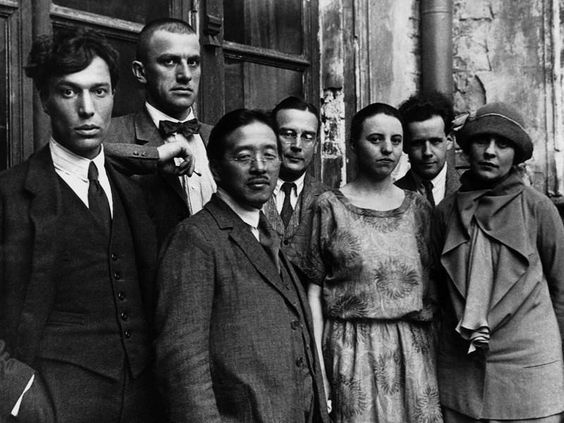Revolutionary Russia’s avant-garde with the Japanese writer Tamiji Naito, Moscow, May 1924 (photo by Anatoly Cemenka). From left to right: Pasternak, Mayakovsky, Naito, (diplomat) Arseny Voznesensky, Olga Tretyakova, Eisenstein, and Lilia (or Lili) Brik. Mayakovsky always seemed to tower over these gatherings, as he does in this photo with that ubiquitous fag.
Pasternak adored Mayakovsky, that is abundantly clear from his experimental autobiography Safe Conduct (1931). (“I deified him. For me he was the personification of my spiritual horizon”, writes the later author of Dr. Zhivago.) The last page of his memoir references Mayakovsky’s suicide, and contains these ominous lines: “Suddenly, outside, underneath the window I imagined I saw his (Mayakovsky’s) life, which now already belonged entirely to the past. I saw it move obliquely from the window like a quiet tree-bordered street resembling the Povarskaya. And the first to take its stand in this street, by the very wall, was our State, our unprecedented and unbelievable State, rushing headlong towards the ages and accepted by them for ever.”
Olga was the wife of the famous art critic and writer Sergei Tretyakov and a movie star who acted in films like “The Fight for the Ultimatum Factory” (1923). Her husband Sergei was one of the founders of the Constructivist journal LEF which he ran with Mayakovsky. Tretyakov is said to have “supplied the ‘heavy’ theoretical reasoning behind Lef’s programme”. Lef’s editorial office was the 2nd floor Moscow flat of Osip and Lili Brik, to which people were constantly coming and going. (Lili and Mayakovsky were lovers from 1917 to 1923, while she was married to his publisher Osip Brik. This didn’t stop Osip from being Mayakovsky’s “most fervent proselytizer”. When they married in 1912 Lili and Osip “had made a pact to love each other in the ‘Chernyshevsky manner’, a reference to the 19th century radical’s advocacy of “open marriages”, which explains the Briks’ polyamory. One writer who knew of these relationships tells us that “In 1918, when Mayakovsky and the Briks became inseparable, he simply moved in with them” and continued to live in the succession of flats they occupied.)
This seemingly harmless photo would have fatal consequences for Olga and her husband Sergei. Anne Tucker, curator of photography at the Museum of Fine Arts, Houston, reports that Naito’s “appearance in the photo would ultimately be used (by Stalin) to support trumped-up charges against one of his Russian friends”. “Olga Tretyakova was later sentenced to prison for being in this picture with Naito” and eventually died in the Gulag. “And a second picture taken at the same time was used in the trial of Tretyakova’s husband, the critic Tretyakov, to show he collaborated with the Japanese.” He was arrested on 25 July, 1937, charged with espionage, and executed in September the same year, although it’s also reported that “in a last act of defiance he threw himself to his death down the stairwell at Butyrka prison”.
But storm clouds have gathered since the Russian archives were thrown open in 1990. Lili Brik committed suicide in 1978 at the age of eighty-six. Mayakovsky’s biographer Jangfeldt states that “by 1922 it was widely known that Osip was working for the Soviet secret police” and that Mayakovsky knew this. It is also alleged that Lili herself was later recruited into the secret police (the NKVD). All of which gives a new twist to Pasternak’s image of “our unprecedented and unbelievable State”, of its power to keep tabs even on the most revolutionary cultural movements of the time.
by Jairus Banaji
http://photowings.org/story-behind-the-picture-a-gathering…/

